There’s a refreshing change afoot in our otherwise conservative Indian car space these days. Carmarkers are finally, in earnest, looking past the practicality, the fuel economy figures and cushy ride quality, and are adding a dose of excitement to their offerings. Mind you, there will always be a diesel variant with mushy suspension that does 25-plus-kpl, but nowadays, you can also buy something that puts fun at the forefront. Mind you, I’m not talking about some high-end fashion statement that will smash a hole in your bank account. These are still mainstream brands and mainstream cars, so they’re still practical, somewhat efficient, comfortable and good value, but they’ve been designed to offer a bit more zing for the relative few who’d like it. And when the most mainstream carmaker of them all – Maruti – hops on the bandwagon, you know it’s catching on.
First, an apology to the new Maruti Baleno RS. I drove it on the Buddh International Circuit last month and, though it was plenty quick, I found it slightly lacking in the thrills department. That wasn’t entirely fair, because the Buddh is so vast and sweeping, it can make 500hp sportscars feel unexciting, let alone a 102hp hatchback. So what I needed to do was take the RS onto some of our favourite roads and give it a real shot. And while out there, I thought I’d bring along some company – two more premium hatchbacks with turbocharged petrol motors and attainable price tags that promise a little bit more than their run-of-the-mill stablemates.
The Polo GT TSI has long been one of our most highly recommended hatchbacks. It was such a breath of fresh air when launched and a great combination of added performance with automatic convenience. It uses a high-tech direct-injection turbo-petrol engine mated to an equally high-tech DSG double-clutch automatic gearbox – this was usually the preserve of far more expensive cars, but here it was in a sub-10-lakh hatchback.
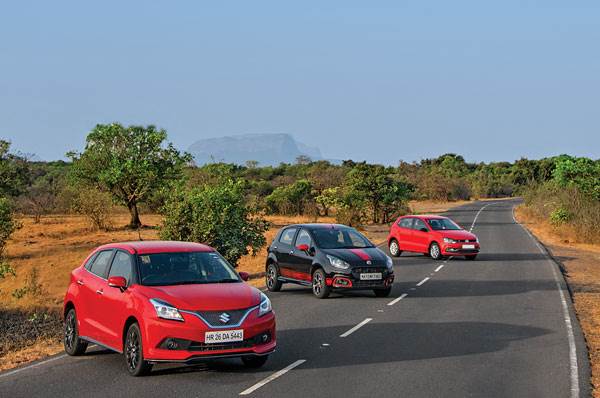
And then there’s the Abarth Punto, which is a far more old-school formula. No direct fuel injection, downsizing or fancy gearbox here; it uses the simple formula of ‘more is more’. It’s the same 1.4-litre T-Jet turbo-petrol motor from the Linea, wound up to a crazy 145hp. Apart from that, the suspension is lowered a bit, disc brakes have been added at the rear and the car has been festooned with stripes and Abarth logos. This one really takes the whole ‘hot hatch’ thing rather seriously.
So clearly, this isn’t a straightforward, apples-to-apples comparison test. The Baleno RS may have a manual gearbox, sporty add-ons and rear disc brakes like ◊ ∆ the Abarth, but the displacement and power output of its 1.0-litre Boosterjet direct-injection motor is closer to that of the Polo GT TSI. What they all have in common is a desire to be more than just a top-of-the-line variant and to give you a bit more driving pleasure as well. So, for somewhere between Rs 9 lakh and Rs 10 lakh, which one should you pick?
Grocery Go-Getters
On the outside, the degree to which these cars differ from their common or garden counterparts is like the three bowls of porridge Goldilocks got to sample. The GT TSI is the cold bowl – almost identical to a standard Polo, save for some black mirror caps, a black spoiler, slightly different alloy wheels and a few badges here and there. The Abarth is like the hot bowl – covered so densely in sporty bits that you could spot it coming from a mile away. It’s even got some rather aggressive-looking alloy wheels. The Baleno RS is the middle ground. The blacked-out headlamps, black wheels (of an unchanged design) and gunmetal grey mesh grille complement the subtle side skirts and chin spoiler. The most dramatic change is the rear bumper, which gets a nice, chunky valance to remind you it means business. The GT is the sleeper, the Abarth the extrovert and the RS somewhere in between, and whichever suits your personality would work for you.
On the inside, the three are all pretty much unchanged from their lesser counterparts, but again, the Abarth goes a little further. It gets red and yellow contrast stitching on the seats and gear lever, all the Fiat badges are replaced by Abarth ones and the cabin is all black. The Polo and the Baleno have exactly the same interiors as the top-spec variants in their respective ranges. Each car has its advantages and disadvantages here. The Baleno is the most spacious and practical, wherever you’re sat. It’s also the best equipped, with goodies like automatic headlamps and the 7.0-inch SmartPlay touchscreen, with Apple CarPlay and navigation. Incidentally, both the Fiat and the VW also now get touchscreens of their own, but our test cars were older models that didn’t have them fitted.

Overall, the Polo is the best from the driver’s seat, with a nice driving position, snug seats, good visibility and a flat-bottom steering wheel to hold on to. It also has the best built interior, with rich-feeling materials and great fit and finish. We would have, however, liked paddle shifters for better control of the gearbox, but you can at least use the gearlever to do the same. The Baleno’s low driving position is good too, but the seats are a bit too flat and soft; fine for everyday driving, but you tend to slide around in them when the car is being driven the way it’s intended. With its racy colour scheme and flamboyantly designed dashboard, the Punto sucks you into the whole ‘Abarth’ experience; the seats too are nice and snug. But then you notice the awkward driving position – you’re sat too high up, almost like you’re in a crossover, the pedals aren’t exactly where you’d expect them and the steering wheel is canted upwards and doesn’t adjust for reach. This is a model that’s, globally, over 12 years old and it really shows, and though it does feel tough, the fit and finish is some way behind the Baleno, let alone the Polo.
Similarly, it’s not high on the practicality in front, with just one cupholder and a tiny dash-top bowl for the driver to store his knick-knacks. The rear seat isn’t great either and feels a touch too snug; it does, however, get a rear AC vent. Mind you, the Polo isn’t great in these respects either, with the smallest boot and a pretty tight back seat, but at least it gets enough cubbyholes. No such issues at all in the Baleno, which being the newest car by far, has all the modern bases covered. It’s a proper four (if not five) seater and has a boot that can eat up your weekend luggage.
The Arsenal
We’ve been fascinated by the idea of the 1.0-litre Suzuki Boosterjet engine ever since we saw it at the 2015 Frankfurt motor show. Ford proved that a lot of fun could be extracted from a 1.0-litre, three-cylinder motor if you bolted on a turbocharger, and we expected more of the same from Maruti’s attempt. However, the outputs are far more modest, and on top of that, the motor has been further detuned for poor fuel quality in India – so what you get is 102hp and 150Nm. Still, thanks to its incredibly light weight, the RS has a healthy power-to-weight ratio of 107.3hp per tonne, and as with all turbocharged engines, the numbers never tell you the whole story.
Take the Polo GT TSI for example – its 105hp and 175Nm too sounded disappointing at first, but after we drove it, we were simply blown away at how smoothly and rapidly this thing made progress. VW is all about high-tech, and the company was one of the pioneers of bringing downsized, direct-injection turbo motors to the masses. It is also paired with arguably the best gearbox in the world, VW’s DSG double-clutch automatic. So, while some might argue that such a car should have a manual, you soon realise that this car can shift faster and smoother than you could ever manage yourself.
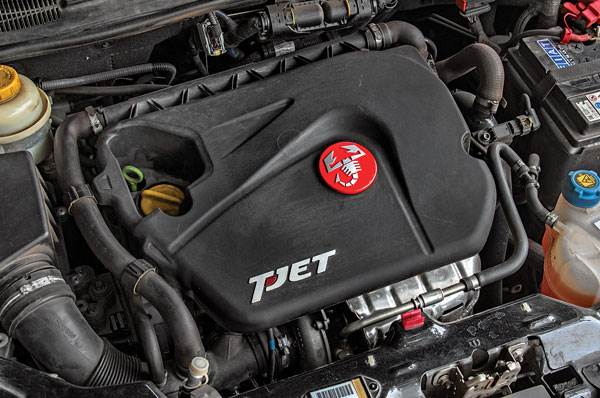
Which brings us to the Punto, which threw out the rule book, set it on fire and then drove over it three or four times to make sure it was dead. 145hp and 212Nm were just unheard of in a car of this price until the Abarth came along, and still, no other hatchback until the Rs 25 lakh mark even comes close. Sure, it feels the tallest from the driver’s seat, thanks to that high perch, but really it’s been lowered by 10mm from the standard Punto Evo, making it the lowest to the ground of these three. And, old it may be, but the Fiat does have an inherently solid chassis setup, and even an old-school hydraulically assisted power steering, which has a lot of promise around the bends.
Pedal to the metal
The Baleno RS comes as an incredible breath of fresh air compared to the original Balenos, which always felt like they prioritised fuel economy and ease of driving over any form of excitement, when you got behind the wheel. There is a very slight lull while the turbo spools up, but as the tacho needle crests 1,600rpm, you’re shot forward.
From then on, it pulls really cleanly all the way to 6,000rpm, where a rev limiter cuts in – there’s no hiccup in the delivery, just a constant, ever-expanding wave of torque. It helps, of course, that the clutch is still really light and the gear shift super precise as well, with its really short throws. Factor in the nice little thrum from the three-cylinder motor and it only adds to the joy of hustling this peppy Maruti hatch down the road. However, you have to remember to keep the engine on the boil to maintain a constant momentum; if it drops below 2,000rpm, you have to work it back into the rhythm.

I’ll have to admit, after this, the Polo GT TSI does feel a bit anticlimactic. The same kind of breezy progress is being made when you flatten your foot, but there’s no drama to it at all. The engine is much smoother, the gearbox handles the shifts seamlessly and it goes about its business with such ruthless efficiency that it does rob you of some of the fun. Of course, the 175Nm does pin you back in your seat when you unleash it, but there’s very little accompanying noise or anything else to make this feel a bit more engaging. But on the flip side, that does mean it’s a lot easier to access that performance, without making the slightest effort.
If you plan to launch the Abarth as fast as it can go, forget effort, you need to have all your faculties about you. All that torque going through the front wheels and the not-very-grippy Bridgestone tyres make for quite a challenge. You will be fighting wheelspin and torque steer in first, second and third gears; so you have to be very careful not to overcook it. Impressively, the higher 1.4-litre displacement means there’s enough grunt off-boost, so you don’t feel as much of a ‘snap’ when the turbo kicks in. Still, there’s just so much torque that you can hardly call it manageable. The hard work doesn’t stop there – the clutch is on the heavy side, and the gearshift action feels chunky and rubbery.
Where you’ll be thankful for a sense of weight and heft in the Abarth is through the corners. Yes, the hydraulically assisted steering is a bit heavier than the electric setups of the other two at parking speeds, but boy, does it give you good feedback going up a mountain road. At first you’ll find the tyres being overwhelmed again, but soon you learn how to drive around that. It’s important not to accelerate into corners, but rather enter them on a trailing throttle; once you’ve got a clear exit, floor it and let all that torque yank you out. Initially, you might expect quite a bit of body roll, but it’s not too bad; just the awkward seating position that makes you feel too high off the ground. This car is a thrill-a-second hatchback – a bit of a handful, but so much fun in the process.
Now the Polo’s powertrain may not lend itself to the kind of involvement you get from the other two, but it has to be said, this is a fun handler. It feels a little loose and a little soft, but always grippy and tied down, so that only adds to the fun of driving it. Yes, you get some body roll and yes, the steering isn’t full of feedback, but turn-in is sharp and you can hustle this small hatch around bends quite easily. And, since the gearbox is so good at anticipating shift points, more so in Sport mode, you can focus on getting the steering just right. Of course, it’s really hard to compare the power delivery of this one to the others, thanks to that gearbox. It shifts its way around turbo lag so well and even pulls its way out of corners so competently, leaving you with little else to do.

Maruti has made some welcome changes to the chassis, steering and suspension with the Baleno RS, but not because it’s an RS. These will actually be rolled out to all Balenos from now on and are in the interest of better crash-worthiness. The structure has been reinforced, and this has added about 60kg to the kerb weight (still a featherweight 950kg), so the suspension has been stiffened to compensate. The steering also has clearly been retuned, and though it’s still not the most communicative or quick, it does have a lot more weight than before and it, mercifully, returns to centre far more cooperatively after you’ve turned it.
It all comes together to make the RS quite a bit more fun to fling around than the original Baleno. Yes, there’s still quite a bit of squat, dive and body roll and certainly doesn’t feel as tied down to the road as either of the other two, but that gives it a loose and frisky feeling that’s fun in its own right. The nose is certainly very eager to dive into corners, and the tail follows, usually accompanied by some protest from the tyres. It also rides a little better than before, and you certainly don’t get tossed around over undulations like you used to. The Polo’s ride too is really supple and takes all but the sharpest of bumps in its stride. But amazingly, it’s the Punto that rides the best of the lot, just steamrolling over everything and taking it all in its stride.
How do they compare against the clock? Maruti has managed a pretty impressive 10.25sec to 100kph with the Baleno RS, which makes it quicker than the Polo’s 11.02sec. Of course, being an automatic, the Polo gets it back in kickdown acceleration, doing 40-100 in 8.10sec to the Baleno’s 12.53sec in fourth, and 20-80 in 6.48sec compared to the Baleno’s 9.48sec in third. The heavy Abarth is actually the slowest at in-gear acceleration, taking 13.55sec and 10.44sec to do those sprints, respectively. But from a standstill, it just creams the other two with a staggering 9.32sec 0-100kph time!
One Of These Is Not Like The Others
When Fiat first stuffed 100hp into a Palio over 15 years ago, we never thought we’d actually see the day that affordable, relatively quick hatchbacks would grow into a proper segment, but finally, that has happened. What’s more, it’s introducing Indians to the thrills of small-capacity turbo motors, which are just a whole different kind of fun on their own, with their solid mid-range kick. And these three have vastly different approaches to the formula and, therefore, will appeal to different people.
The Polo GT TSI has a superb Jekyll-and-Hyde ability to go from comfortable, automatic city runabout one moment, to zippy little firecracker the next. Its performance is just so easy to access that even those who aren’t all-out petrolheads will find some enjoyment in it, and they can do it without sacrificing the convenience of an auto gearbox in the process. It’s just that in this company, it’s not quite as engaging to drive. But if you want the best of both worlds, this could be your pick.
You might be of the view, and rightly so, that a do-it-all hatchback means it has to be practical too. I mean, why shouldn’t your hopped-up turbo hatch have proper space, a big boot and all the amenities we’ve come to demand these days? And the Baleno RS has all of that. It also manages to be quite nice to drive, with much better road manners than before, and at Rs 8.69 lakh (ex-showroom, Delhi), it’s the cheapest of this lot too. It’s just that, while the Boosterjet engine is an improvement, we can’t help but feel it could have been better still, and the Baleno RS still errs too much on the side of sensible to be an all-out entertainer.
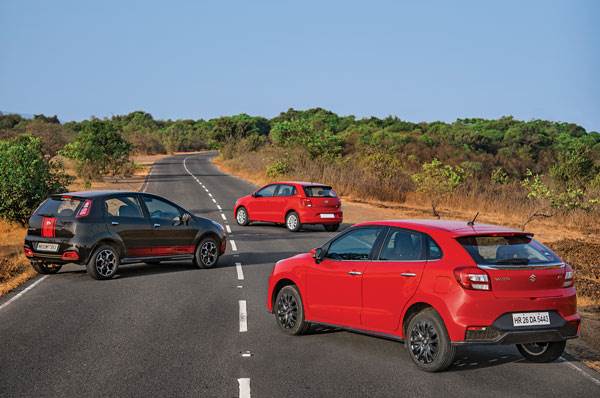
The Abarth Punto is in no way practical. There’s a dearth of storage spaces, the ergonomics are terrible, the infotainment system is buggy and some of the controls are counter-intuitive. It also feels decidedly old in this company, and cabin quality and the equipment list leave a lot to be desired. But as a mechanical package, it is just spot on. The motor puts a grin on your face and holds it there until you turn the car off, the steering just sucks you into the driving experience and the chassis manages to be both taut around corners and comfy over bumps. Plus, it really looks the business.
Let’s put it this way, if we were comparing the standard versions of these cars, the Punto would come dead last. And while sensible things like build quality and practicality are important here too, performance and excitement are even more so in this segment. So, though it’s the most expensive, and it has its fair share of shortcomings as a car, the thrills it serves let it race ahead of the others. While the other two are merely warmed up, the Abarth is a proper hot hatch, and that’s why it’s our pick.
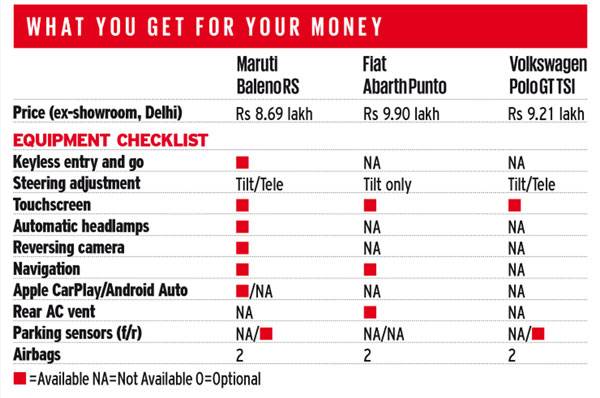


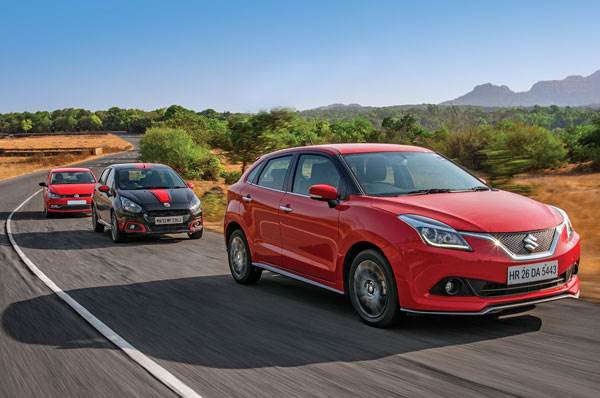
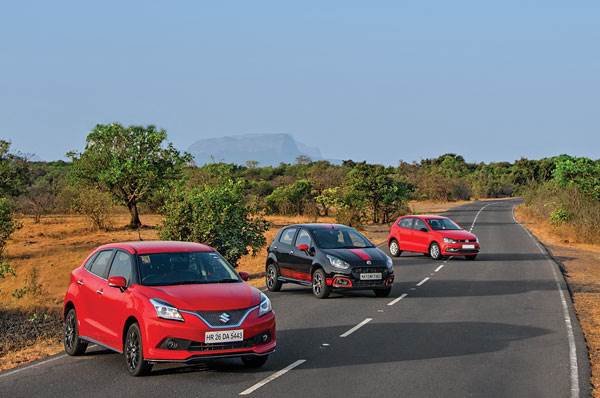
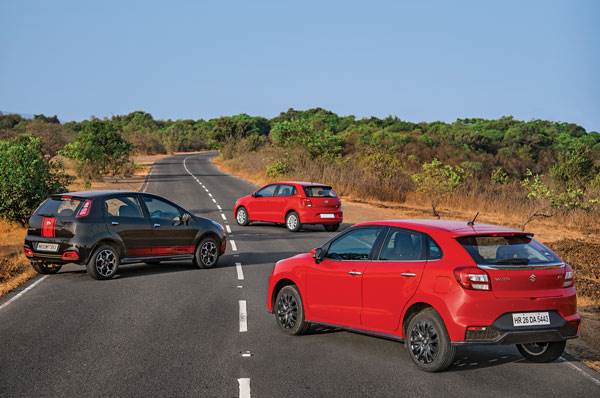
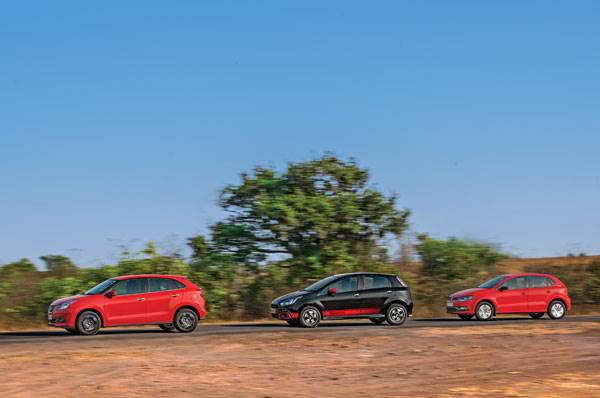

Comments
Member Login
Personal Details
No comments yet. Be the first to comment.